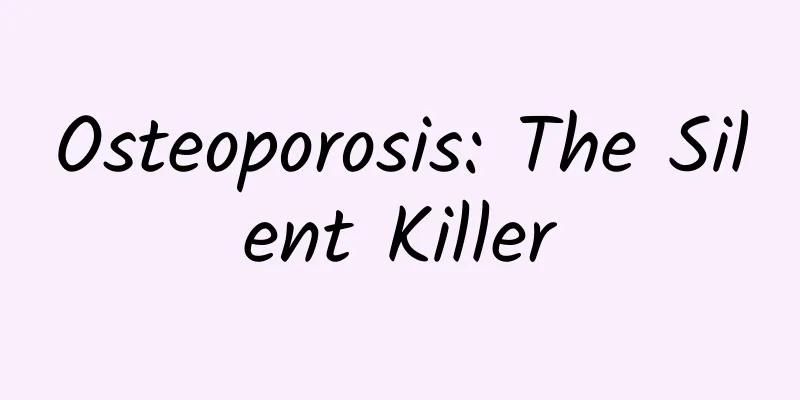Osteoporosis: The Silent Killer

|
As the saying goes, "As people age, their bones become hollow." This is not quite accurate, but it does make sense. Due to endocrine changes, estrogen decreases, calcium intake and absorption decrease, and vitamin D synthesis and activation decrease, which causes bone loss and damage. Although blood calcium is normal, the hard bones have become loose and fragile skeletons. This is osteoporosis. It has a mysterious nickname - "silent killer"! Because osteoporosis may not have symptoms such as pain at the beginning, and it develops quietly until fractures of the spine, hip bones, wrist bones, etc. occur. What is osteoporosis? Osteoporosis is a chronic bone metabolic disease. The patient's bone density decreases, making the bone structure fragile and prone to fractures. The size, shape and structural density of bones change with age. Generally speaking, bone mass grows rapidly during childhood and adolescence, reaches its peak in the 30s, and remains at its highest level during young adulthood. At around 40 years old, bone loss begins to become obvious; at the same time, menopausal women will experience increased bone loss due to a decrease in estrogen in their bodies. When bone loss is faster than normal, the probability of osteoporosis and fractures increases. Does osteoporosis always cause bone pain? Not necessarily. Osteoporosis itself does not have any obvious symptoms. If you feel pain, it is usually due to a fracture. Patients may suffer fractures due to minor collisions or falls. Even without any collision, the spine will gradually collapse, causing the back to become curved, forming a hunchback and becoming shorter. Some patients also experience back pain. How to prevent and treat osteoporosis? Build strong bones during childhood and adolescence. Calcium and vitamin D help bones reach their peak bone density. Even if you have been diagnosed with osteoporosis, you can slow down the rate of bone loss by adopting a healthy lifestyle. 1. Eat a balanced diet and ensure adequate intake of calcium and vitamin D. 2. Get enough sun exposure. A moderate amount of sunlight helps the body produce vitamin D, which helps absorb calcium. 3. Do appropriate exercise, especially some moderate weight-bearing exercises, such as: Tai Chi, jogging, brisk walking, dancing, tennis, badminton, etc. 4. Maintain a proper weight. 5. Quit smoking and limit alcohol consumption. 6. Avoid drinking too much caffeinated beverages, such as coffee and strong tea. 7. If you are diagnosed with osteoporosis, you should take appropriate measures to prevent fractures. It is recommended to go to the hospital for regular physical examinations. The doctor will recommend calcium supplements, estrogen, vitamin D, bisphosphonates or calcitonin, etc., depending on the specific situation. Do I need to take calcium tablets to supplement calcium? If you cannot get enough calcium from your diet due to certain medical reasons such as lactose intolerance, the need for long-term steroid treatment, or intestinal diseases such as inflammatory bowel disease or irritable bowel syndrome, you should consult a doctor and take appropriate calcium supplements. How to supplement vitamin D? Vitamin D is mainly synthesized in the body after the ultraviolet rays in the sun hit the skin. Exposing the face and arms to mild sunlight for about ten minutes a day can allow women with lighter skin to produce enough vitamin D. Women with darker skin will need a relatively longer time, but remember to avoid the strong sun. The amount of vitamin D provided by food is limited, and diet alone cannot meet the body's needs. Vitamin D mainly comes from high-fat fish such as salmon, sardines, mackerel, tuna, cod, eel, etc., egg yolks, and dairy products or soy milk fortified with vitamin D. Can proper stretching exercises help with osteoporosis? Stretching exercises can help increase the body's flexibility and balance, but they are not enough to maintain bone health. It is recommended to do more outdoor activities and get enough sun exposure. Warm up for 5-10 minutes before any physical activity. If you feel uncomfortable during physical activities, you should stop immediately and consult a doctor as soon as possible. If you have health problems such as chronic diseases, it is recommended to consult a professional doctor before exercising. Friendly reminder Bone loss is a natural phenomenon. Healthy living is the foundation for building strong bones during childhood and adolescence. Let's learn the following tips for building strong bones. I hope everyone can have strong bones and a healthy life. Tips for strengthening bones The road is straight, health is the first; Eat a balanced diet, don’t be perfunctory; Milk, beans, nuts, vegetables, fruits should also be added; After dinner, I went out to bask in the sun. The sun was at D3. Moderate exercise is optional, with weight-bearing exercise being a priority; Quit smoking, drinking and drinking, limit strong tea, take action and don’t relax; To prevent osteoporosis, regular physical examinations are the key; If you are unfortunate enough to have a fracture, scientific medical insurance will help you stay healthy. |
<<: Light sleep, deep sleep and dreaming, these are the things you need to know
Recommend
Symptoms of hypoxia in late pregnancy
All the baby's nutrition comes from the amnio...
What is the best way to treat scanty menstruation?
Generally, women will have their first period whe...
comScore: US smartphone market share data for July 2012
Smartphone share in the U.S. as of July 2012 The ...
Women should be careful of serious consequences when undergoing fire therapy!
Fire therapy is to apply medicine on the body, th...
Can I drink Longjing tea during menstruation?
Longjing tea is a very precious tea that is loved...
The three-year-old boy often fell for no reason and was found to be suffering from "senile disease"
When it comes to cataracts People's first rea...
My eyes are on fire while working from home. How can I cure dry eyes?
Working at a desk for a long time at home, someti...
I am 19 weeks pregnant and still can't feel the fetal movement. What's going on?
Many people are first-time mothers. Women are oft...
Traditional Chinese medicine treats pelvic inflammatory disease, these methods say goodbye to pelvic inflammatory disease
Pelvic inflammatory disease is a common gynecolog...
Dull abdominal pain one week before period
Before menstruation comes, women often have many ...
"Senior Health Promotion Week" | Expert advice: Elderly people should actively and reasonably get vaccinated
Population aging has become an important trend in...
How many days after menstruation can I test for pregnancy
It is actually not easy to get pregnant after men...
What are the methods of breast massage during menstruation
I believe that many female friends are familiar w...









